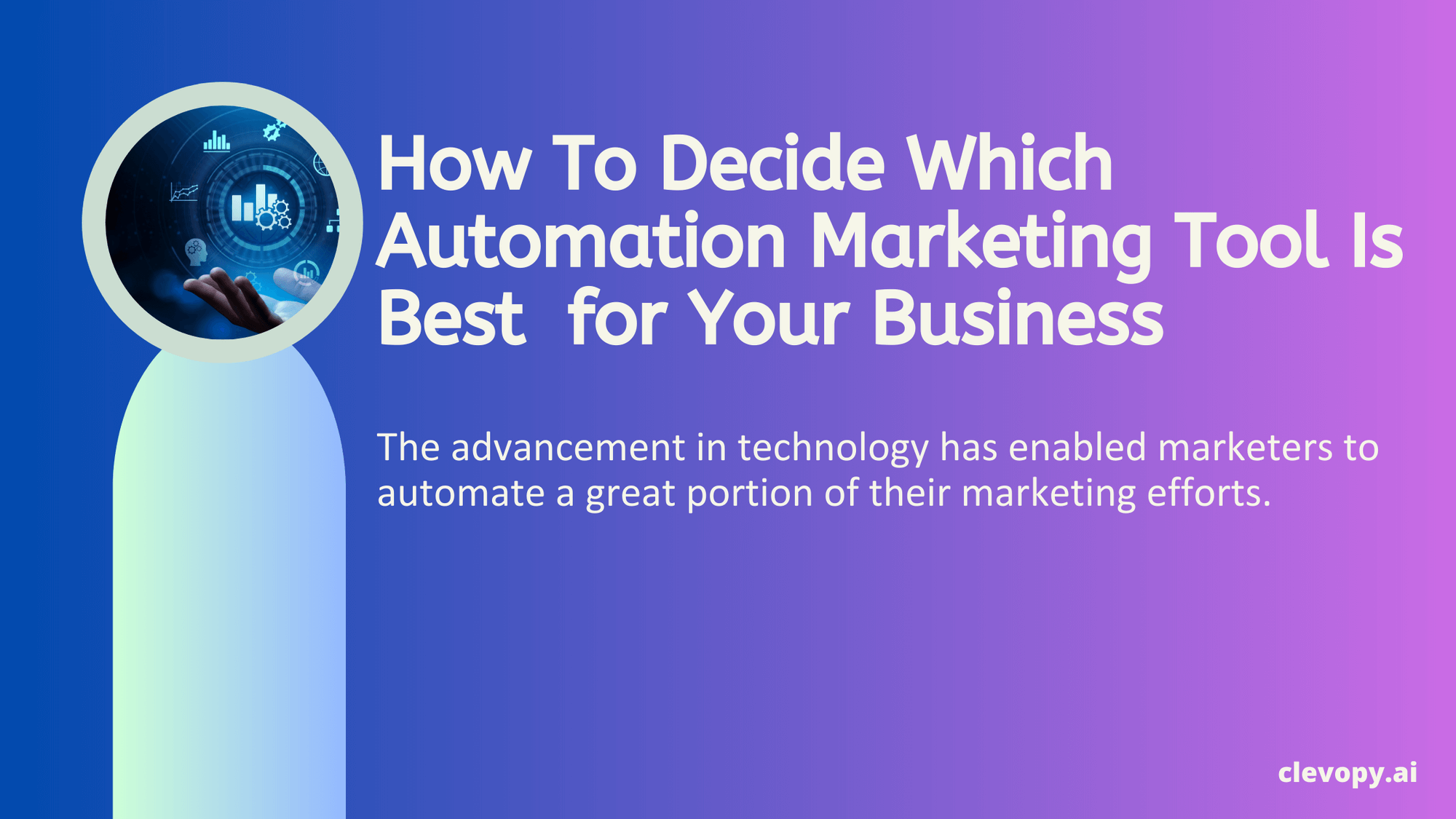Choosing the best automation marketing tool for your business requires careful consideration of several factors.
Here's a step-by-step guide to help you make an informed decision:
Define Your Marketing Goals and Needs:
- Identify your specific marketing goals and objectives. Determine what areas of your marketing processes you want to automate and improve.
- Consider your business size, industry, target audience, and marketing budget. Assess the complexity and scale of your marketing operations.
When it comes to developing an effective marketing strategy, setting clear and attainable goals is crucial.
Achieving desired results requires a comprehensive understanding of the target market, product or service offerings, and competition. By taking the time to define your objectives, you can ensure that your marketing efforts are both successful and measurable.
The first step in defining marketing goals is to determine what you would like to achieve. Ask yourself: What do I want my customers or clients to do?
Do I want them to purchase a product, sign up for a service, or engage with content?
Once you have identified the desired outcome, you will need to explore the required steps that will help you get there.
Common tactics include email campaigns, social media posts, online ads, search engine optimization (SEO), website content writing, and tradeshows.
In order to develop a plan that best suits your needs, assess your current situation. Analyze metrics such as website visits and conversion rates along with customer feedback from surveys or reviews.
This data can provide valuable insight into where improvements are necessary in order to capture more leads or increase customer loyalty. With this information in hand, uncover areas of opportunity in terms of messaging tailored to certain target segments.
It’s also beneficial to evaluate all resources available including budgets for any campaigns as well as staff hours dedicated specifically to marketing efforts. Be realistic when considering how much time and money goes into each segment so that expectations are set appropriately.
Knowing exactly what can be accomplished within budget constraints allows marketers to identify areas where they can reach further with allocated resources.
Establish SMART (specific, measurable, achievable, relevant, and timely) goals which should be clearly outlined within a timeline regarding when they should be met; whether that be 3 months or one year out.
Keep in mind that if any objectives are not being reached according to plan due to a lack of resources or changes in customer behavior—be prepared for agile adaptation while keeping the overall vision intact.
By closely examining your business needs and taking the time needed upfront strategizing around specific goals and objectives for their achievement will ultimately make for effective marketing plans down the road.
Identify Key Features and Functionality:
- Make a list of essential features and functionality you require from an automation marketing tool. This may include email marketing, lead generation, customer segmentation, analytics, social media management, CRM integration, and more.
- Prioritize the features that align with your business goals and will have the most significant impact on your marketing effectiveness.
The key features of marketing automation include:
- Content creation: Marketers can use marketing automation to quickly and easily create high-quality content that is optimized for maximum reach and engagement. This includes blog posts, social media content, eBooks, infographics, webinars, emails, and other forms of digital content.
- Lead generation: Automating lead capture allows marketers to collect data from prospects in order to nurture them into customers. This process can include automated emails or text messages sent on behalf of the company.
- CRM integration: Marketing automation software can integrate with customer relationship management software (CRM) to share customer information across departments. This helps sales teams quickly access customer data while also allowing marketers to segment leads based on customer data.
- Campaign tracking and analytics: Automated tools make it easier for companies to track the progress of their campaigns. This includes a detailed overview of all the campaigns being run as well as insights into which channels are most effective.
- Social media engagement: Automation tools can be used to monitor social media conversations related to a company’s products or services. This makes it easier for marketers to respond quickly to customers on social media platforms.
Research and Compare Available Tools:
- Conduct thorough research to identify automation marketing tools that meet your requirements. Explore reputable review websites, attend industry forums, and consult with other businesses in your industry to gather insights and recommendations.
- Compare the features, pricing plans, scalability, user interface, customer support, and user reviews of different tools. Pay attention to the reputation and track record of the tool providers.
When selecting the right tools for your business’s marketing automation needs, there are a few key factors you should consider.
First, think about the specific goals you hope to achieve with marketing automation.
Do you want to increase customer retention?
Improve online presence? Increase sales? All of these goals should inform the type of tools you select.
The next step is to research and compare different available tools. Some of the most popular options include MailChimp, HubSpot, and Marketo.
All three offer comprehensive features designed specifically for marketing automation. However, each one has its own unique set of capabilities and benefits that may be better suited for certain applications or industries.
Consider Integration and Compatibility:
- Evaluate how well the automation marketing tool integrates with your existing marketing technology stack. Check whether it can seamlessly integrate with your CRM system, website, analytics tools, and other platforms you use.
- Consider the ease of implementation and the learning curve associated with adopting the tool. Assess whether it requires extensive technical expertise or if it offers user-friendly interfaces and intuitive workflows.
Integrating different tools is essential for marketers to reach their goals such as increasing leads or improving customer engagement.
Having an integrated approach can give your organization a more holistic view of what’s going on with your campaigns. It also allows you to measure outcomes accurately by creating consistent metrics across all channels.
A great way to achieve this is through “Marketing Automation Integration", which uses APIs (Application Programming Interfaces) to link multiple programs together that are related to different aspects of marketing activities.
This integration allows marketers to move data from one system or platform to another without needing manual input or manually transferring information, significantly streamlining their workflows and allowing them to spend more time on strategy rather than operations.
API integrations allow different software systems such as CRM systems, web-to-lead forms, analytics platforms, and internal databases to easily send data back and forth between each other.
This helps marketers achieve tremendous efficiencies when it comes to customer engagement and lead generation as they no longer have to manually copy information from one place to another.
Request Demos and Trials:
- Request demos or free trials from the shortlisted tools to get hands-on experience. This will help you evaluate the user interface, ease of use, and overall user experience of each tool.
- During the demos or trials, test the tool's functionality, performance, customization options, reporting capabilities, and overall reliability. Pay attention to the tool's responsiveness, stability, and whether it meets your specific needs.
One way that companies can take advantage of marketing automation is by requesting demos and trials. This practice allows businesses to experience first-hand how this technology works, as well as learn more about its capabilities.
Additionally, it gives them an opportunity to look into different features and options before making a decision about which system is best suited for their unique needs.
When considering whether or not to request demos and trials for marketing automation, there are a few things to keep in mind.
First off, it’s important to select the right vendor who can provide you with the necessary guidance when implementing your system.
It’s important that you decide on features that fit your company’s needs. Finally, by performing thorough research on different vendors and systems available, you will be able to find one that fits your particular business.
Requesting demos and trials can be a great way for companies to gain more information about how marketing automation works, get familiar with potential features they may want to be incorporated into their system, and identify any areas where they need further clarification before making their final decision.
Although companies may be hesitant at first due to fears of taking up too much of a vendor’s time or resources, most vendors do understand why it is beneficial for them as well as the customer and will try their best to accommodate such requests.
Therefore if you believe that trying out various types of marketing automation would be beneficial for your business then feel free to reach out to different vendors in order to get detailed information regarding demos and trial options available so you can make an informed choice.
Consider Scalability and Future Needs:
- Evaluate how well the automation marketing tool can scale your business growth. Consider whether it can handle increasing volumes of data, leads, and campaigns as your business expands.
- Assess whether the tool offers additional features or advanced plans that can accommodate your future marketing needs and strategies.
In order to achieve successful scalability with a marketing automation platform, it is essential that businesses take the time to research potential platforms thoroughly.
They should focus on the core features and capabilities of each platform in order to ensure they have the ability to effectively scale up as their business grows. It is also important to ensure that the marketing automation platform can handle any additional complexities or specific requirements a business may encounter in the future.
Additionally, feature-rich and flexible integration options are key for businesses looking for effective scalability with their marketing automation system.
By embracing an API-driven approach, businesses are able to integrate with existing systems and leverage future integrations more easily. This will help them ensure that their system always meets current and future needs.
Data management is also an important factor when it comes to scaling up a marketing automation system.
Businesses should look for platforms offering comprehensive data management capabilities so they can easily capture, track, manage, and measure data points across all channels and campaigns.
They should also be sure that the platform offers robust tools for analyzing data so they can gain valuable insights from customer behavior and preferences.
Finally, when considering scalability and future needs for a marketing automation system, cost should be taken into account. It is important for businesses to understand how pricing works before committing to any platform in order to avoid unexpected charges in the future due to increasing costs associated with larger campaigns.
In conclusion, scalability and future needs are important considerations when selecting a marketing automation platform.
Taking the time upfront to research potential platforms thoroughly will help businesses ensure they select one which meets their current requirements as well as having the capacity for growth - providing them with long-term value.
Analyze Costs and ROI:
- Consider the pricing structure and subscription plans of each automation marketing tool. Compare the costs against the features and value they offer.
- Analyze the potential return on investment (ROI) of each tool by estimating the time and cost savings, improved efficiency, increased conversions, and overall marketing performance enhancements they can provide.
The first step in analyzing the costs and ROI of marketing automation is to identify what resources are needed for implementation. This includes technical resources, staff time, internal systems, third-party applications, data storage, and software licenses. Once these resources have been identified, it is important to quantify them in terms of cost and use this information to create a budget for your campaign.
Once the budget has been established, it's important to measure the effectiveness of various activities throughout the campaign.
This includes tracking various metrics such as open rates, click-through rates, lead conversion rates, sales generated by leads generated through marketing automation campaigns, etc. These metrics are essential in providing insight into how well your campaign is performing and where improvements can be made.
It's also important to track other areas that may not directly relate to success but may still affect overall ROI.
These include associated expenses including hiring staff or contractors for tasks related to marketing automation implementation as well as any additional fees associated with third-party applications used during the setup or execution of campaigns. It's also important to consider associated expenses such as hosting websites or social media accounts related to marketing automation initiatives.
Finally, another key factor in evaluating costs and ROI for marketing automation is taking into account any intangible benefits or boosts in customer satisfaction resulting from successfully managing automated campaigns.
These cannot be tracked directly but can still result in significant long-term impacts on a company's bottom line.
Measuring the costs and ROI of marketing automation requires diligent planning and tracking throughout an entire campaign.
By carefully evaluating each element discussed above one can get a better understanding of what resources are needed for an effective campaign as well as potential impacts on customer satisfaction that may not be easily measured with more traditional metrics.
Seek Recommendations and Feedback:
- Reach out to industry peers, marketing professionals, and business communities to gather feedback and recommendations. Consider their experiences and insights to help inform your decision.
When it comes to marketing automation tools, recommendations and feedback from professionals and experts in the industry can give valuable insight into which products are right for your company.
As you consider different marketing automation tools, it’s important to evaluate user experience, pricing, features, integrations, level of customer success support, and overall scalability.
When asking for recommendations and feedback on marketing automation tools, start by asking people who have already used the tool you are considering. This will help get a good understanding of how the tool works in practice.
Reaching out to colleagues in your network or posting on relevant forums can provide useful results.
Another way to get feedback is through independent review websites. These sites provide unbiased reviews from professionals within the industry with extensive knowledge of various marketing automation tools available.
Potential customers should review these sites when researching solutions as it provides an honest look at features, usability, and customer service.
Many companies are now using third-party software developers that specialize in marketing automation implementations for larger enterprises.
Developers often have comprehensive experience across multiple platforms and can provide guidance on which tool best suits your business needs.
Ultimately, businesses should weigh their options carefully when deciding on a marketing automation tool. It is a decision that requires significant investigation but also has great potential to unlock new opportunities for companies if done correctly.
Make an Informed Decision:
- Based on the evaluation of features, compatibility, scalability, user experience, costs, and feedback, make a well-informed decision on the automation marketing tool that best suits your business needs and objectives.
Top 10 Recommended Marketing Automation Solutions to Consider
The advancement in technology has enabled marketers to automate a great portion of their marketing efforts. Automation is a way of streamlining operations and making processes simpler and faster.
This leads to cost savings, improved efficiency, and increased productivity. In this article, we will be discussing the top 10 automation marketing tools that can help you improve your overall digital marketing performance.
You can also use clevopy.ai tools for research purposes on marketing automation tools and to generate content that resonates with your audience.
1. Marketo By Adobe:

Marketo is an automated marketing platform that helps businesses create compelling campaigns that engage customers. It enables marketers to quickly build personalized customer relationships with targeted email campaigns and automated workflows based on user behavior.
2. MailChimp by Intuit:
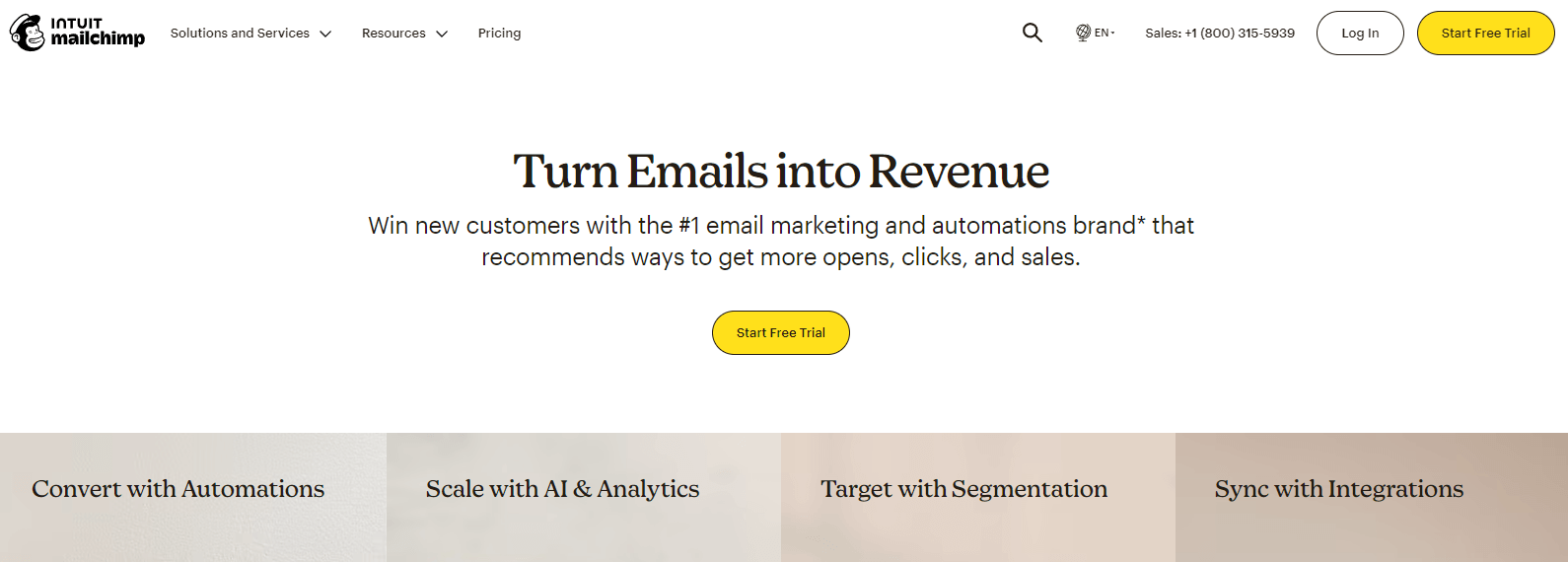
MailChimp is an easy-to-use automation marketing tool designed for both small business owners and large enterprises alike. It offers features such as list segmentation, automated emails, A/B testing, and targeted campaigns.
3. HubSpot:

HubSpot is a powerful automation marketing platform that helps organizations generate leads through lead management tools, content creation and management, custom landing pages, social media monitoring tools, and more.
4. Pardot by Salesforce:

Pardot is an automation marketing solution used by many companies across different industries all over the world. It offers various features such as lead scoring, lead nurturing, customer relationship management (CRM) integration, social media outreach tools, and much more. Currently integrated into salesforce.
5. Keap:

Keap is a comprehensive automation marketing platform that helps drive sales growth by automating email campaigns, supporting online businesses through shopping cart software, and handling large-scale contact database management.
6. ActiveCampaign:

ActiveCampaign combines all the features of traditional email service providers with powerful automation to ensure high levels of customer engagement for eCommerce stores.
7. Autopilot:
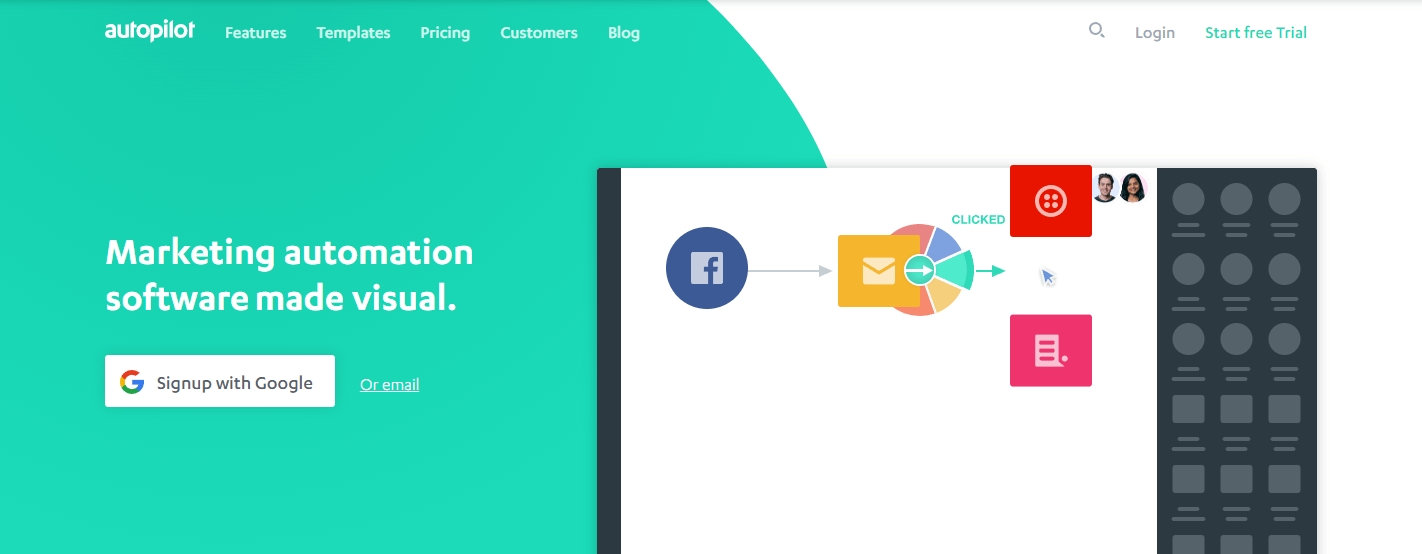
Autopilot is an automation software specifically designed for digital marketers who are looking for ways to personalize their communications with customers at scale.
8. Omnisend:
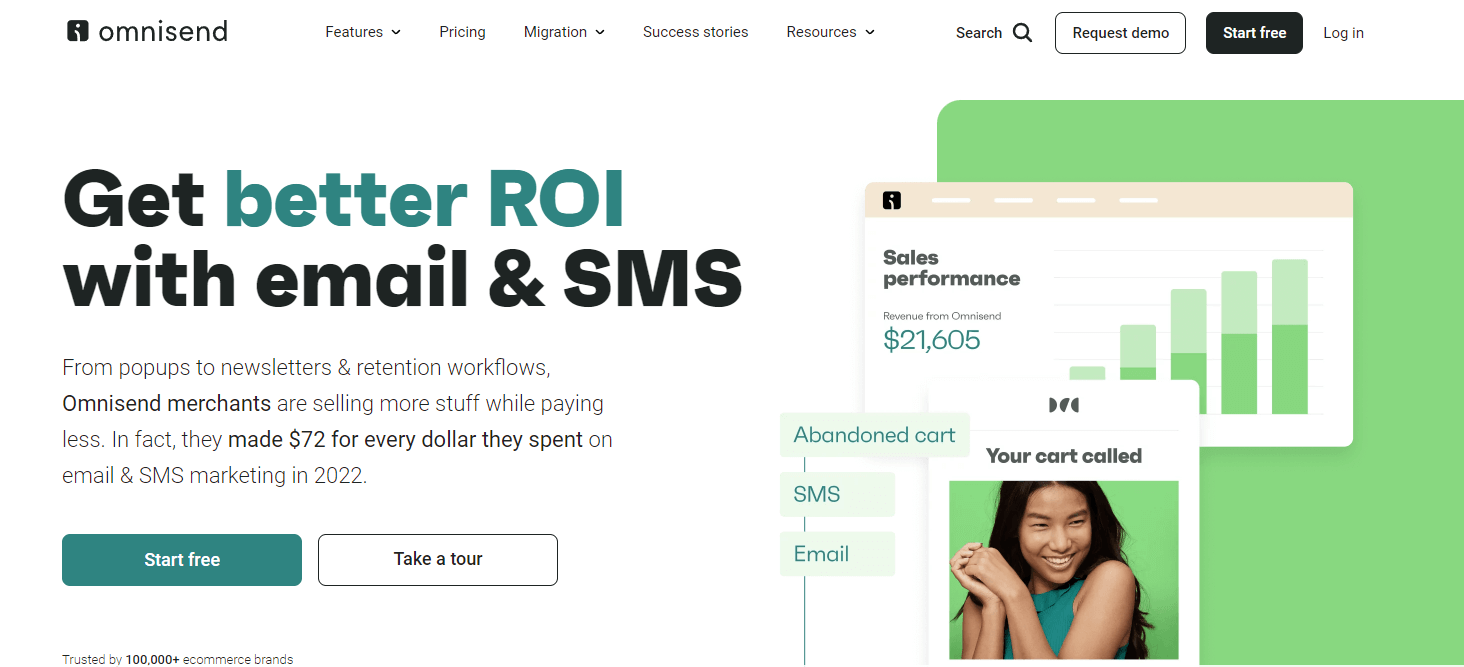
Omnisend provides automated email campaigns powered by AI technology which allows businesses to send personalized messages based on customer behavior in real-time or set up triggered sequences (onboarding flows).
9. Zapier:

Zapier integrates multiple applications into one interface so that users can easily integrate two or more services without manual work. This makes it easy to create workflows that automate repetitive tasks.
10. LeadSquared:
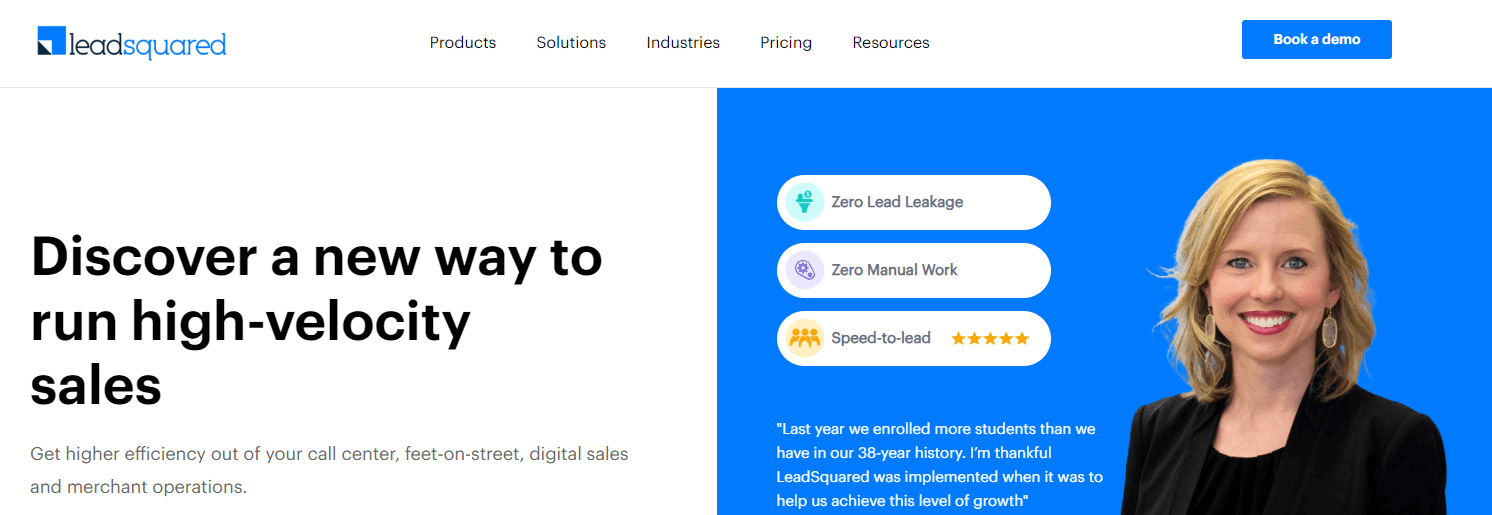
LeadSquared is an end-to-end cloud-based marketing solution for any size of business that includes features like automated lead capture & nurturing flows; smart forms & analytics; integrated CRM along with customized workflows.
Conclusion
Remember that selecting an automation marketing tool is not a one-size-fits-all approach. Choose a tool that aligns with your specific requirements, resources, and growth plans. Regularly assess and re-evaluate your marketing needs and goals to ensure the chosen tool continues to meet your evolving business requirements.
